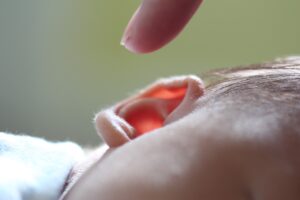Auditory Neuropathy Spectrum Disorder (ANSD)
What is auditory neuropathy spectrum disorder?
Auditory neuropathy spectrum disorder (ANSD) is a recently described disorder that impacts how one hears and understands speech. Essentially, it is abnormal speech perception; affected individuals are able to physically hear words, but it is difficult for them to make sense of or understand them. This disorder typically impacts children and is diagnosed early in life.
What are the symptoms of auditory neuropathy spectrum disorder?
Symptoms of ANSD vary among affected individuals, with possible effects including difficulty understanding spoken words, mild to severe hearing loss, impaired speech perception, problems determining where speech is coming from, and difficulty understanding speech that worsens in loud environments.
There are signs of this disorder that parents can look for in their children as well. If you notice that your child doesn’t turn around or respond to loud noises, is not laughing or making sounds by eight months of age, or does not try to recreate sounds by twelve months of age, then they may have ANSD.
What causes auditory neuropathy spectrum disorder?
ANSD is caused by a defect in one of the following areas:
- Inner hair cells
- Auditory nerve
- Connection between the auditory nerve and brain
- Connection between the auditory nerve and inner hair cells
In most cases, both ears are impacted by these defects, although some affected individuals only see symptoms in one ear. These defects then stop the brain from being able to process speech or audio, which can range from mild hearing loss to functional deafness.
Many things can cause these defects, such as genetic mutations, infections, congenital brain abnormalities, premature birth, low birth weight, intracranial hemorrhage, inadequate oxygen supply to the body, excess bilirubin in the blood, drugs with toxic effects on the ears, and a family history of ANSD. In some cases, this disorder is linked to another condition, such as Charcot-Marie-Tooth disease (CMT).
How is auditory neuropathy spectrum disorder diagnosed?
A number of hearing tests will be used in order to diagnose this condition. They are otoacoustic emission (OAE) tests, middle ear muscle reflex (MEMR) tests, auditory brainstem response (ABR) tests, cochlear microphonic (CM) tests, speech audiometry, and pure tone audiogram testing. The results of these tests must meet the following criteria in order for there to be an ANSD diagnosis: severely abnormal or absent response to the highest level on ABR tests and normal outer hair cell function shown on CM and OAE tests.
After a diagnosis is established, further tests may be necessary to establish disease severity. A patient must be at least one year old for these tests, and they include genetic testing, MRIs, ophthalmology testing, and ongoing language and speech testing.
What are the treatments for auditory neuropathy spectrum disorder?
Treatment is decided based on the cause of one’s ANSD, disease severity, and clinical deficits. Options include speech-language therapy (SLP), hearing aids, cochlear implants, and frequency modulation systems.
Where can I find out more about auditory neuropathy spectrum disorder?
ANSD Articles





